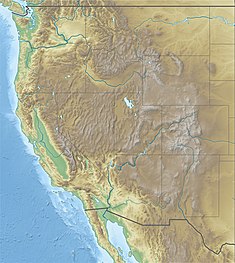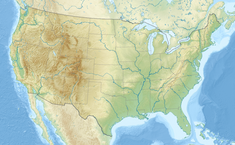Grand Coulee Dam
| Grand Coulee Dam | |
|---|---|

The dam as viewed from near the visitor center
|
|
|
Location of the dam in the western U.S.
|
|
| Country | United States |
| Location | Grant / Okanogan counties, near Coulee Dam and Grand Coulee, Washington |
| Coordinates | 47°57′21″N 118°58′54″W / 47.95583°N 118.98167°WCoordinates: 47°57′21″N 118°58′54″W / 47.95583°N 118.98167°W |
| Purpose | Power, regulation, irrigation |
| Status | Operational |
| Construction began | July 16, 1933 |
| Opening date | June 1, 1942 |
| Construction cost | Original dam: $168 million Third Powerplant: $730 million |
| Operator(s) | U.S. Bureau of Reclamation |
| Dam and spillways | |
| Type of dam | Concrete gravity |
| Impounds | Columbia River |
| Height | 550 ft (168 m) |
| Length | 5,223 feet (1,592 m) |
| Width (crest) | 30 ft (9 m) |
| Width (base) | 500 ft (152 m) |
| Dam volume | 11,975,520 cu yd (9,155,942 m3) |
| Spillway type | Service, drum gate |
| Spillway capacity | 1,000,000 cu ft/s (28,317 m3/s) |
| Reservoir | |
| Creates |
Franklin Delano Roosevelt Lake Banks Lake |
| Total capacity | 9,562,000 acre·ft (12 km3) |
| Active capacity | 5,185,400 acre·ft (6 km3) |
| Catchment area | 74,100 sq mi (191,918 km2) |
| Surface area | 125 sq mi (324 km2) |
| Power station | |
| Commission date | 1941–1950 (Left/Right) 1975–1980 (Third) 1973–1984 (PS) |
| Type | Conventional, pumped-storage |
| Hydraulic head | 380 ft (116 m) |
| Turbines | 33: 27 × Francis turbines 6 × pump-generators |
| Installed capacity | 6,809 MW 7,079 MW (max) |
| Capacity factor | 36% |
| Annual generation | 20.24 TWh |
|
Website http://www.usbr.gov/pn/grandcoulee/ |
|
Grand Coulee Dam is a gravity dam on the Columbia River in the U.S. state of Washington, built to produce hydroelectric power and provide irrigation water. It was constructed between 1933 and 1942, originally with only two powerhouses. The third powerhouse, completed in 1974 to increase energy production, makes Grand Coulee the largest electric power-producing facility in the United States.
The proposal to build the dam was the focus of a bitter debate during the 1920s between two groups. One group wanted to irrigate the ancient Grand Coulee with a gravity canal, and the other supported a high dam and pumping scheme. Dam supporters won in 1933, but for fiscal reasons the initial design was for a "low dam" 290 feet (88 m) tall which would generate electricity, but not support irrigation. The U.S. Bureau of Reclamation and a consortium of three companies called MWAK (Mason-Walsh-Atkinson Kier Company) began construction that year. After visiting the construction site in August 1934, President Franklin Delano Roosevelt began endorsing the "high dam" design which, at 550 ft (168 m) high, would provide enough electricity to pump water to irrigate the Columbia Basin. The high dam was approved by Congress in 1935 and completed in 1942; the first water over-topped its spillway on June 1 of that year.
Power from the dam fueled the growing industries of the Northwest United States during World War II. Between 1967 and 1974, the third powerplant was constructed. The decision to construct the additional facility was influenced by growing energy demand, regulated river flows stipulated in the Columbia River Treaty with Canada, and competition with the Soviet Union. Through a series of upgrades and the installation of pump-generators, the dam now supplies four power stations with an installed capacity of 6,809 MW. As the center-piece of the Columbia Basin Project, the dam's reservoir supplies water for the irrigation of 671,000 acres (2,700 km2).
...
Wikipedia


